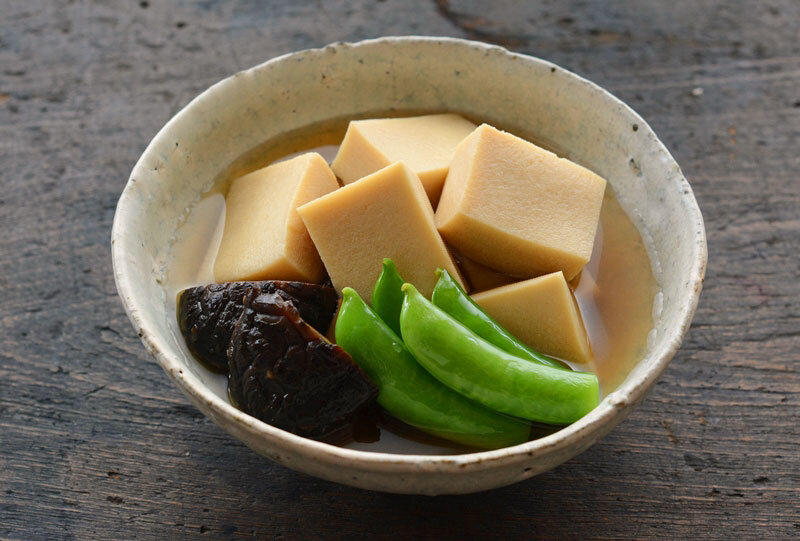Like many across the world, the JASH staff has turned to cooking during quarantine—not just for sustenance but for comfort and entertainment, too.
For Week 9 of Friday Favorites, we share with you what we have been cooking:
Japanese Potato Salad (ポテトサラダ)
Kanitama (かに玉)
Koya Tofu (こうや豆腐)
Potato and Beef Croquettes (コロッケ)
Wan-fone (奄美風豚骨)
Zosui (雑炊)
Read staff comments below for a few easy-to-follow Japanese recipes to add to your cooking repertoire.
Enjoy.
IKUYO
Image from Ikuyo Katayama
Wan-fone (奄美風豚骨)
My father’s hometown, Amami Oshima, is located in the East China Sea between Kyushu and Okinawa. Wan-fone, the Amami Oshima Style Cooked Spareribs, is actually a very important food for celebrations in Amami Oshima, especially on New Year’s Eve. It is a very soft and juicy, country style pork dish which is based on my family’s recipe. I believe it is a good challenge for cooking lovers to learn about different food culture while we continue to be under quarantine.
*Please note: if you do not have a pressure cooker, use a deep pot and cook the meat until soft.
Ingredients:
200ml of cooking sake
1-1.5 tablespoon of natural salt
1 pack of tonkotsu (cut pork spareribs):
3.5 lbs. - I usually buy this at H-mart
Directions:
Soak the tonkotsu in water for at least 30
minutes.Clean and rise the meat well.
Rub the pork with salt and leave it in the refrigerator overnight.
Rinse the meat quickly, then place into a pressure cooker* and add enough water to cover the meat.
Boil for 1-2 minutes without a lid, then drain the water and rinse the meat. It is important to take the foam off of the meat.
Put the meat back in the cooker and add cooking sake and fresh water, just enough to cover the meat.
Close the lid, then cook with high heat until
pressure becomes high.Switch to low heat mode and cook for 30 minutes
with pressure.Turn off the heat and leave the cooker until
completely cool.Skim off the fat that appears on the top.
Warm before serving.
KEIKO
Image from Keiko Tsubokura
Kanitama (かに玉)
Since the beginning of quarantine, I have been trying to intake protein to keep up my strength and maintain my health. One of my favorite meals is called kanitama. Kani means crab and tama mean egg in Japanese. Egg is the easiest protein for me to make and it is low in calories. This dish is like an omelet, so feel free to add some items from your fridge.
Ingredients:
crab meat
egg
green onion
salt and pepper
ketchup (optional)
sambal oelek sauce (optional)
Directions:
Cut the crab into small pieces and chop the green onion.
Mix together the egg, chopped green onion, and crab pieces.
Add salt and pepper to taste.
Cook the mixture in a pan.
Decorate with ketchup. (If you like spicy, mix ketchup and sambal oelek sauce.)
LAUREN
Image from Lauren Hurley
Potato and Beef Croquettes (コロッケ)
My favorite Japanese meal that I’ve prepared during the stay at home order has been potato and beef croquettes or korokke.
Being from a non-Japanese household, my family does not enjoy eating a majority of Japanese meals, so when I do make something, I need to appeal to their non-adventurous tastes. Thus, korokke with katsu sauce.
Ingredients:
2-3 large potatoes
1 tbsp butter
1/2 onion
1 bay leaf
1 lb. ground beef
salt and pepper to taste
1 tbsp white wine
3 tbsp milk
oil for deep-frying
flour
beaten egg
panko bread crumbs
For katsu sauce:
3 parts ketchup
1 part Worcestershire sauce
Directions:
Chop onion finely and saute with butter in a skillet until tender.
Add bay leaf and beef, cook until brown and crumbled.
Add salt, pepper, and wine. Cook for 3-5 minutes.
Remove the bay leaf and set aside.
Boil peeled and chopped potatoes until tender. Drain then mash.
Combine meat and onions with potato. Add milk and mix until thick and soft. Set aside to cool.
Prepare oil for frying, approx. 350 degrees Fahrenheit.
Separate potato mixture into equal, oval portions.
Coat each oval with flour, egg, and breadcrumbs in this order.
Fry until crispy brown. Remove from oil to drain.
Serve with shredded cabbage and katsu sauce.
MEGUMI
Image from Megumi Hirose
Japanese Potato Salad
(ポテトサラダ)
Potato salad is a regular favorite in many houses in Japan. Every household has its own way of making it and typically has a secret ingredient, kakushi aji, that makes it the family’s own taste of potato salad. In my recipe, vinegar is used as the secret ingredient. Other seasonings used as the secret ingredients are such as a pinch of sugar, miso paste, soy sauce and consommé seasoning. My mother's potato salad has onions, cucumbers, carrots, and ham in it, but some may have chopped boiled eggs instead of ham, or both of them, or without onions- it all depends on the family.
Since it is easy to make various shapes with potato salad, people like to make “Potato Salad Christmas Tree” or “Potato Salad Christmas Wreath”, which are garnished beautifully with cut vegetables, as a Christmas dish in Japan.
*Any mayonnaise, but Kewpie Mayonnaise can make the most authentically Japanese flavor.
Ingredients:
400g potato (about 0.9 pounds)
1/2 white onion
1/2 english cucumber
1/2 carrot
5 slices ham
160 mL mayonnaise* (about 3/4 cup)
a pinch of salt
1-2 tbsp. vinegar (optional)
Directions:
Boil potatoes. When tender, drain and mash. Set aside to cool.
Thinly slice the onion and add salt to remove the milk. Rinse thoroughly and drain. Set aside.
After cutting the carrot into half-moon slices, boil until tender. Drain and set aside to cool.
Thinly slice the cucumber and add salt to remove the water. Wait about 10-15 minutes, then squeeze the slices firmly. Set aside.
Slice the ham thinly and set aside.
Add all ingredients to a large bowl and mix with mayonnaise.
Add salt and/or vinegar to taste.
For garnishing, cut the carrot and ham in the shape of your preference with the cookie cutter, and slice the cucumber thinly into a long strip if you wish to make “Potato Wreath”.
MIDORI
Image from 白ごはん.com
Koya Tofu (こうや豆腐)
My go to meal while Houston has been under quarantine is called koya tofu (こうや豆腐) and it combines freeze-dried tofu with shiitake mushrooms and fresh vegetables. The recipe dates back to the Kamakura period (1185-1333) when Buddhist monks on Mt. Koya accidentally created freeze-dried tofu and found that it is good way to preserve fresh tofu.
You can buy koya tofu kits at most asian markets.
Ingredients:
4 dried shiitake mushrooms
4 pieces of koya tofu
10 small shishido peppers
dashi broth
Dashi Broth:
1 tsp of hondashi
Pinch of salt
1 tbsp sake
1 tbsp soy sauce
66 grams (6 tbsp) sugar
Directions:
Soak shiitake mushrooms in 1 c of water for 30-45 minutes, then remove the mushrooms and reserve the liquid.
Dip the freeze-dried tofu in shiitake water until soft then gently wring out like a sponge.
Dissolve hondashi, sugar, soy sauce, sake and salt in a small saucepan and add 2 c water. Place over low heat and bring to a simmer.
Add the tofu, shiitake mushrooms, shishido peppers. Simmer on low heat until the broth reduces.
Serve as a soup or slice the tofu into strips and arrange on a plate.
PATSY
Image from nhk.or.jp
Zosui (雑炊)
Soup is my go-to comfort food, and when combined with rice, there is nothing more soothing!
During quarantine, I have been eating Zosui regularly. The Japanese rice soup, which is cooked in a savory dashi broth with vegetables, egg, and sometimes meat or seafood, is not only comforting but also nourishing.
Moreover, with pantry ready ingredients, it can easily be made it in no time!
Ingredients:
Dashi broth
1 dashi packet
3 cups water
2 tsp soy sauce
1/2 tsp kosher/sea salt
Vegetables (whatever is in your refrigerator!)
recommended:
2 shiitake mushrooms
1/4 of a carrot
2 green onions/scallions
1 1/2 rice bowls of cooked Japanese short-grain rice
1 large egg
1/2 tsp toasted white sesame seeds
1/8 tsp white pepper powder
Directions:
Add water and dashi packet to large pot. Cover with a lid and slowly bring to boil on low heat. After a few minutes, shake the packet to release more flavor.
Continue to heat. Once boiling, cook for 3 minutes and then remove dashi packet and discard.
Keep the lid closed and set aside.
Thinly slice the shiitake mushrooms and carrot. Also dice the green onions and save for use as garnish at the end.
If using cold cooked rice, put in fine-mesh sieve and rinse under running water to remove excess starch. Shake and drain well. If using freshly cooked rice, you can skip this process.
Add carrots to the dashi broth and cook covered until tender, approximately 4-5 minutes.
Once the carrot is tender, add soy sauce and salt to the broth.
Add shiitake mushrooms and well-drained cooked rice. Cover and cook for 10 minutes.
Beat the egg in a bowl. Slowly drizzle a small amount of the beaten egg over the soup surface.
Add some green onion and sesame seeds.
Sprinkle with white pepper powder and serve!







